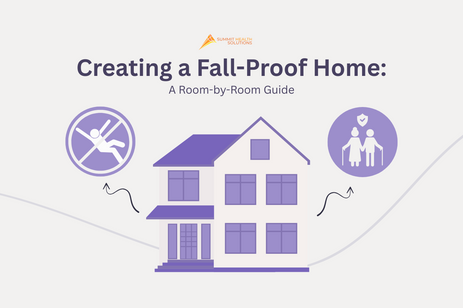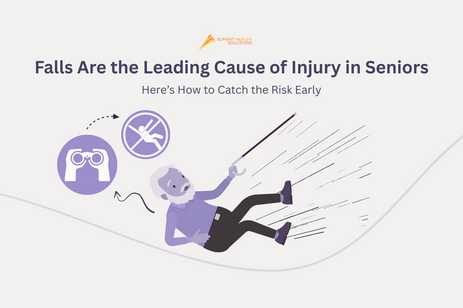
Why Falls Happen — And How We Help Prevent Them
👟 Falls are not just accidents—they’re often preventable events that reflect deeper health concerns. According to the Australian Institute of Health and Welfare, falls were the most common cause of injury-related hospitalisations in 2023–24 and the leading cause of injury-related deaths in 2022–23.
For adults aged 65 and older, a simple fall can lead to serious outcomes: physical injury, loss of independence, psychological stress, and financial strain. In nursing homes, the concern is amplified—nearly half of residents experience at least one fall per year. Repeated fallers tend to be women, and many are unaware of just how preventable these incidents can be.
What Causes Falls in Older Adults?
🧠 Falls are rarely random. They stem from a combination of:
-
Reduced muscle strength
-
Poor balance and gait
-
Visual impairments
-
Medication side effects (especially psychoactive drugs)
-
Environmental hazards like loose rugs, poor lighting, or cluttered walkway
While many older adults make home modifications—grab rails, alarm systems, reachable shelves—these changes address only part of the puzzle. Falls don’t just result from slippery floors but from underlying physical vulnerabilities.
How Can We Spot Those at Risk?
🧪 Screening is key. Simple questions about:
-
Prior falls
-
Feelings of unsteadiness
-
Fear of falling
Combined with basic tests—such as the Timed Up and Go and Sit-to-Stand—can help identify if someone’s at low, moderate, or high risk.
But spotting risk isn’t enough. Taking meaningful action is what changes outcomes.
Science-Backed Strategies That Actually Work
💪 The good news? Many fall risk factors are modifiable.
Recent research shows progressive exercise programs improve strength and balance for community-dwelling older adults. Studies find:
-
Resistance exercises boost muscle tone
-
Aerobic components support cardiovascular health
-
Specific balance movements reduce instability
-
Combined programs offer the most benefit
And the best part? You don’t have to be a gym junkie. Even gentle, guided home exercises can spark significant improvements.
Beyond Exercise: A Multifactorial Prevention Approach
🩺 For high-risk individuals—those with fractures, repeated falls, or medical conditions—a holistic fall prevention plan is essential. This can include:
-
Vitamin D supplementation
-
Bone health assessments
-
Medication reviews
-
Vision optimization
-
Home safety evaluations by occupational therapists
-
Podiatry care to improve foot health and footwear
-
In rare cases, even pacemaker insertion for issues like carotid sinus hypersensitivity
These interventions are often delivered through falls clinics and connected liaison services, ensuring personalized, science-led care that truly makes a difference.
So, How Do We Help?
🌐 We believe fall prevention should be accessible, empowering—and a little bit fun. That’s why we offer online telehealth exercise programs designed specifically for older adults.
Our classes help participants:
-
Build strength safely from home
-
Improve coordination and balance
-
Gain confidence in movement
-
Connect with a supportive virtual community
Led by certified professionals, each session blends mobility-focused routines with education, helping you understand why each movement matters. Whether you’re post-fracture, feeling unsure on your feet, or just looking to stay active, these classes meet you where you are—literally.
Frequently Asked Questions:
Q: Why do some older adults resist fall prevention programs—even when they’re at risk?
A: Many seniors associate fall prevention with frailty, dependency, or aging — things they may not want to confront. Some don’t want to be labeled as “at risk” or may think avoiding activity is safer. That’s why programs that build strength and confidence, rather than emphasize fear, tend to engage people more effectively.
Q: Is fear of falling actually a fall risk factor itself?
A: Yes. The fear of falling can lead older adults to limit their movement, avoid going out, or stop exercising. This leads to muscle weakening, poorer balance, and ironically, a greater chance of falling. It becomes a vicious cycle. Addressing fear with education, movement, and support is essential to breaking it.
Q: Do caregivers play a role in fall prevention?
A: Absolutely. Family members, home health aides, and nursing staff often notice early signs of instability—hesitation when walking, holding onto walls, or subtle changes in movement. Their role in monitoring, encouraging exercise, and adjusting the environment is often the frontline of fall prevention, especially for individuals who may not recognize the risks themselves.
Q: Is fall prevention just about avoiding injury—or something more?
A: It’s much more. Preventing falls isn’t just about bones and bruises — it’s about protecting independence, confidence, and quality of life. A serious fall can take away someone’s freedom to live at home, socialize, or move without fear. So fall prevention is ultimately about preserving dignity and autonomy, not just physical safety.
🎯 Falls don’t have to define your journey. With a bit of science, a dash of motivation, and the right support system, you can move with strength, confidence, and joy.
Sign up now to download your FREE Exercise Guide and take your first step toward better balance!





